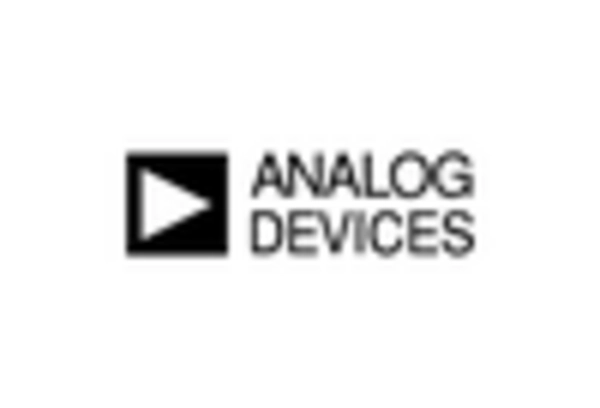Growth of Electric Powertrains
The automotive semiconductor market is poised for growth due to the increasing adoption of electric powertrains. As manufacturers transition from internal combustion engines to electric vehicles (EVs), the demand for specialized semiconductors rises. In 2025, it is estimated that EVs will account for over 25% of new vehicle sales in the US, necessitating advanced semiconductor solutions for battery management systems, power electronics, and electric motor control. This shift not only supports environmental sustainability but also drives innovation within the automotive semiconductor market, as companies develop more efficient and powerful chips to meet the evolving needs of electric vehicles.
Integration of Smart Technologies in Vehicles
The market is significantly influenced by the integration of smart technologies in vehicles. As consumers increasingly demand connectivity features, such as infotainment systems and vehicle-to-everything (V2X) communication, the need for advanced semiconductors escalates. By 2025, the market for connected vehicles is projected to exceed $50 billion, highlighting the critical role of semiconductors in enabling these technologies. This integration enhances user experience and safety, as vehicles become more interactive and responsive. Consequently, the automotive semiconductor market is likely to see substantial growth as manufacturers invest innovative semiconductor solutions to meet these consumer demands.
Regulatory Push for Enhanced Safety Standards
The automotive semiconductor market is affected by a regulatory push for enhanced safety standards in vehicles. Government agencies are increasingly mandating advanced safety features, which necessitate the use of sophisticated semiconductor technologies. In 2025, it is anticipated that regulations will require all new vehicles to include certain ADAS features, further driving the demand for semiconductors. This regulatory environment compels manufacturers to invest in advanced semiconductor solutions to comply with safety standards, thereby propelling growth within the automotive semiconductor market. As regulations evolve, the market is likely to adapt, fostering innovation and development in semiconductor technologies.
Surge in Demand for Advanced Driver Assistance Systems
The automotive semiconductor market experiences a notable surge in demand for Advanced Driver Assistance Systems (ADAS). This trend is driven by increasing consumer expectations for safety and convenience features in vehicles. In 2025, the market for ADAS is projected to reach approximately $30 billion, indicating a robust growth trajectory. The integration of semiconductors in these systems enhances functionalities such as lane-keeping assistance, adaptive cruise control, and automatic emergency braking. As automakers prioritize safety, the The automotive semiconductor market is likely to benefit significantly from this shift. Semiconductors play a crucial role in enabling these advanced features.
Rising Consumer Preference for Enhanced In-Vehicle Experience
The automotive semiconductor market is influenced by the rising consumer preference for an enhanced in-vehicle experience. As consumers seek more personalized and interactive features, automakers are compelled to integrate advanced technologies into their vehicles. This trend is reflected in the increasing demand for semiconductors that support high-definition displays, advanced audio systems, and seamless connectivity. By 2025, the market for in-vehicle infotainment systems is projected to reach approximately $20 billion, underscoring the importance of semiconductors in delivering these experiences. Consequently, the automotive semiconductor market is likely to expand as manufacturers prioritize the development of innovative semiconductor solutions to meet evolving consumer expectations.















Leave a Comment